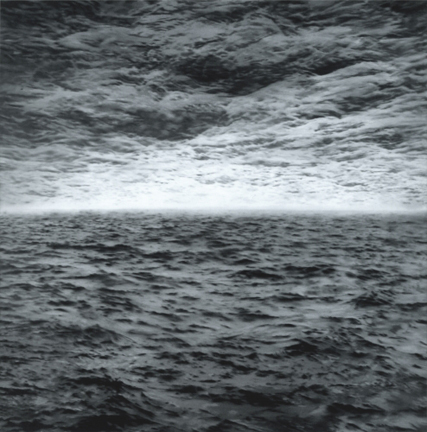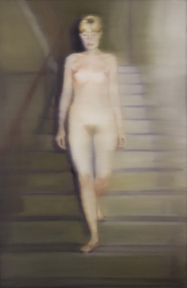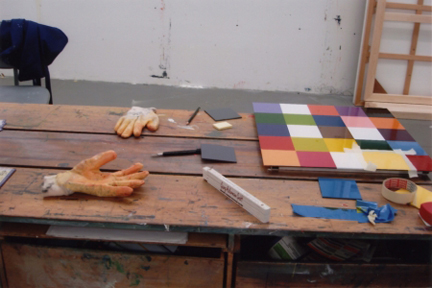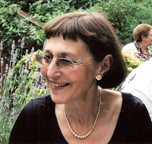|
Gerhard Richter: Panorama at Tate
Modern
by Anna Leung

|
| Gerhard Richter, Seascape (Sea-Sea), 1970. |
Art the highest form of
hope!
We
need beauty in all its variations
From the late nineteen sixties and into
the seventies painting was in decline–some think it still is. Many painters, convinced that painting was an act of deception
that yielded only illusions, turned to performance, photography or film and video, representational modes that did not rely
on illusionistic devices. Gerhard Richter was one of the few who continued to paint while at the same time addressing this
problem of representation from within the oil-on-canvas tradition.
What was targeted during this period of transition was the assumption that paint had an idealist content and could,
as Abstract Expressionism intimated, convey metaphysical or transcendental meaning. After Abstract Expressionism, a more self
critical, reductionist, non-illusionistic and in some cases ironic mode of operation came to dominate painting practices.
While for the most part retaining painting’s rectangular format emphasis was placed on singular and material attributes
such as linear, colouristic or surface qualities (Stella, Ryman). In this way hierarchical and compositional effects were
reduced to virtual zero as was content or subject matter. As Stella succinctly put it ‘My painting is based on the fact
that only what can be seen there, is there….what you see is what you see.’. Cutting edge art across the board
was in the main objective, cool, cerebral, dispassionate and self-referential. Its philosophical ethos was positivism laced
with phenomenology and its goal was to repress all evidence of self-expression and thereby eliminate possibilities of ambiguity.
Thus during a period marked by great social and political displacement and unrest a kind of tautological game was being played
in which artists nevertheless saw themselves as resistant fighters against the status-quo. Richter risked being seen as conservative
since the consensus was that painting, especially of the oil on canvas variety, was intrinsically not avant-garde.

|
| Gerhard Richter, Table (Tisch), 1962. |
Gerhard Richter’s extremely productive
career needs to be seen against this shift in attitudes and expectations when pictorial references were no longer drawn directly
from the natural world but from an ever-growing nexus of information. Empirical data was being rapidly replaced by conceptual
data. From 1961 when he settled in West Germany Richter alternated between figuration and non-figuration treating a wide range
of subjects and employing a wide variety of means while not valuing one practice over another. As we shall see Richter is
equally adept at dealing with historical genres such as the nude, landscape, portraits and history painting as he is in investigating
colour and its absence in his monochromes and colour charts and in his densely layered, explosively coloured abstract canvases.
For Richter, Abstraction is as real as Realism is abstract, for what fascinates him is not the image per se or its absence
but appearance or semblance as our apprehension of appearance. Richter readily admits that it is inevitable that figurative
elements be seen in abstraction and denies any difference between what for him is a false polarity. That this panoply of styles
remains Richter’s consistent trademark throughout his long career can be seen as we wander through the rooms of this
vast exhibition. Each room displays figurative paintings, mostly from photographic imagery, side by side with abstract paintings.
There are two exceptions; the first is the room devoted to 18 October 1977, a cycle of fifteen photo-paintings based
on the deaths of the Baader-Meinhof terrorists in Stammheim high security prison, the second the Cage room of abstract paintings
that brings the exhibition to an close. Throughout the exhibition we see Richter appropriating mutually contradictory trends
associated with Hyperrealism, Minimalism and Conceptual Art while at the same time honing his craft as a painter to produce
some extraordinarily beautiful images. Impossible to categorise he demonstrates his determination to confront the crisis of
representation on one hand and that of Germany’s recent history on the other.
Gerhard
Richter was born in what was to become East Germany in1932 one year before Hitler took power. This meant that he lived through
two totalitarian regimes, making him sceptical of all political ideologies and on the whole intolerant to didactic art at
a time when there was much pressure on avant-gardist artists to be politically committed. Consequently he refuses to see his
art as overtly political unless we count his belief in the reconciliatory task of the aesthetic. The fact that his art education
was in the East meant that he was taught traditional drawing and painting skills but knew little of the modern movement, which
was regarded as bourgeois and therefore reprehensible to the Communist authorities. It was only after graduating as a mural
painter that he made his first trip to the West in 1959 travelling to Kassel to see Documenta II. Here he encountered the
work of Lucio Fontana and Jackson Pollock. Describing their innovations as ‘brazen,’ he had decided by the end
of the year to flee to the West, one year before the Berlin Wall was constructed dividing East from West. His coming over
to capitalist West Germany coincided with the rise of Pop Art, which released him from the obligation to actively choose specific
subject matter (which in the East had been imposed from above by the authorities). Source material was readily at hand in
news photos and magazine advertisements. Richter’s painting practice, however, was always complex: he seemed to embrace
tropes of high and low, the traumatic and the banal, romanticism and kitsch, and also showed divergent allegiances in his
debts to Duchamp (Ema, Nude on a Staircase, his mirror/glass pieces), to Friedrich (romantic landscapes and
cloud and sea studies), to Vermeer (Reader 1994), to Ingres (Betty 1988) and to Beuys (The Chair)--in
short, to both the avant-garde and classical traditions. From the beginning he has reiterated that he knows nothing about
reality, only about its ‘translation’ into pictorial languages, painting’s sign systems, and that it was
precisely his doubts that linked him with classical painters.

|
| Gerhard Richter, Ema (nude descending a staircase), 1992. |
His first paintings were based on images taken
from newspapers and magazines. What he professed to be aiming for, in accordance with the artistic zeitgeist, were images
characterised by ‘no style, no composition, no judgement.’ Thus, armed with Duchampian indifference, his practice
was to project the image on the canvas and proceed to fill it in by hand with a brush. He later added amateur snapshots, including
his own, to his annotated collection of found images, insisting on their quality as pure images bereft of all intentionality.
Wedded to this aesthetic of indifference, it seems more than coincidental that he introduced into his practice subject matter
directly related to Germany’s recent Nazi past, images from his family album (one of the few possessions he brought
over from the East) that most artists would have chosen to keep concealed. Uncle Rudi for instance is a full sizes
portrait of his uncle in the uniform of the Wehrmacht--a going away photo, it turns out, as he was to die some months later.
What distinguishes this portrait and many others is the addition of Richter’s signature blur. Paint has been dragged
across the wet surface with a dry brush, signalling a whole variety of responses. Often interpreted as replicating an
out of focus snapshot, evoking speed, or signalling a temporal distancing by underlining the difference between the ‘now’
of the viewer and the ‘then’ of whatever was captured in the photograph, this flurry of soft or hard brush strokes
also signals a degree of moral and emotional ambiguity - despite the painter’s insistence on a lack of intentionality
on his part. Take his portrait of Aunt Marianne that depicts his maternal aunt cradling Richter as a none-too-happy
baby. A schizophrenic, she was sterilized and eventually starved to death by the Nazis. The blur of the brushstrokes bring
her and the baby together suggesting the very emotional attachment that Richter was initially keen to disavow. During an interview
in 1986 Richter confessed that this dispassionate stance of indifference was mere subterfuge and pretence on his part: “Content
definitely – though I may have denied this at one time, by saying that it had nothing to do with content, because it
was supposed to be about copying a photograph and giving a demonstration of indifference.” (1)
It was near to impossible, especially in post war Germany, to totally cleanse the motif of extraneous
or questionable subject matter. A series of landscapes that Richter started working on in 1968 would inevitably summon up
reflections on Germany’s recent history for it was all too easy to associate the majestic force of the mountains with
nationalistic strivings as exemplified in Leni Riefenstahl’s films Holy Mountain and Blue Light. Richter
does not ennoble The Alps but submits them to a process of disintegration or deconstruction so that, like his cityscapes which
carry conviction from afar, they become mere smudges and brush strokes as you approach them, challenging the expectation of
greater clarity the nearer we get to an image. The same is true of his cloud and seascapes, especially Sea-Sea which
seems initially to aspire to the sublime. One would think that this painting, especially, might suffer from a collapse of
romantic suspension of disbelief as we realise how the image has been collaged together; it is not the stormy sky we think
we see but an upside down image of the sea. Despite this trick/artifice, a residue of romanticism remains and is important
to our understanding of Richter. Faced with our longing to take pleasure in a primordial feeling of oneness with nature, Richter
repeatedly insists that nature is indifferent to our desires. However, the surge of unfulfilled desire to which this gives
rise can be viewed as an aspect of the Northern romantic tradition that attempts to picture what is unrepresentable and is
therefore not totally negative. It underpins Richter’s continued allegiance to Friedrich which comes to the fore in
his beautiful painting of Iceberg in Mist, 1982, that was inspired by Richter’s trip to Greenland in search of
a motif as strong as Friedrich’s The Sea of Ice, 1823.

|
| Gerhard Richter, Candle (Kerze), 1982. |
From the mid-1960s Richter embarked on a series
of abstract paintings based on colour and chose to explore this area in complementary ways. His colour charts replicate
those industrial or commercial colour samples that belong to the urban environment; the colors, confined to their separate
squares, debar the viewer from experiencing them in an expressionistic or naturalistic way. Every colour is a readymade and
there is no hierarchy since every colour is independent of every other colour. The series of Grey Paintings, on the
other hand, dealt with colourlessness but also blocked any inference of composition or internal relationships, being distinguished
from one another only by their textural surface. Artistically placing him in the Minimalist and Conceptualist camp, they were
the equivalent of fundamental painting, reductive painting pared down to its literal, rudimentary and materialist categories
that is closest in its objectives to Stella’s and Ryman’s self- problematising practices. However, Richter realised
that even the Grey Paintings could not entirely escape eliciting illusionistic or symbolic effects which inevitably turn painting
into something other than its material component. Indeed Richter confessed that while his Grey Paintings represented
a terminal point artistically on deeper level they may have been linked to his multiple unsuccessful attempts to paint the
concentration camps.
If as Richter admits the Grey Paintings represented a terminal
point, his Abstracts represented a new beginning, though he did not abandon all previous procedures. At first, his reliance
on source material through photographic enlargement continued as 128 Details from a Picture (Halifax), 1978, demonstrates,
as did his aim to minimise expressivity while fully acknowledging the painting medium. He was not trying to ally himself with
Abstract Expressionism’s search for transcendence any more than his colour charts allied him with Bauhaus colour theories.
If in his colour charts colours were isolated, in the new paintings colours were combined, and the introduction of the squeegee
made photographic source material or a starting image unnecessary. But making paintings remains a lengthy process. Richter
starts with a primed canvas covering it with layers of paint over days or weeks or months as readable elements, be they spatial
or structural, are eliminated. The squeegee creates areas of veiling that seem to reveal and conceal the underlying layers
and in so doing creates impressions of intense spatial complexity and of boundlessness which can be perceived as sudden flarings
up and extinctions of activity like fireworks or reflections and shadows in a swift stream. His aim is to create illusions,
the semblance of images, for as he says ‘there is no colour on canvas which means only itself and nothing more’
and presumably referring to Malevich adds that ‘otherwise the “black square” would only be a stupid coat
of paint.’ Richter’s Abstracts are not about creating intelligible symbols or iconic references but rather stand
as analogies of visual phenomena that continually make and unmake our experience of reality. The marks represent time, not
movement. Richter makes and unmakes his abstract paintings, describing them as ‘a highly planned kind of spontaneity’,
creation and destruction being part of the same process. Scrutinising them does not necessarily provide anything identifiable,
for they present us with momentary interpretations that promise meaning and then gainsay it. Despite the bold colours, this
phantasmagorical world is full of contradiction and indeterminacy, an indeterminacy and doubt that are reflected in his glass
pieces and notably in 18 October 1977.

|
| Gerhard Richter's Studio. Courtesy of the artist. |
From the 1980s onwards, Richter’s practice
tended towards the production of these abstract paintings, which now represent two thirds of his output. However, Richter
did not abandon genre painting. For Richter the two were different ways of achieving a similar aim and it was during this
period that he produced his series of Candles and Skulls and other genre compositions that linked Richter once more to the
Northern Romantic tradition. Among the best loved of these is his portrait of his teenage daughter Betty posing against one
of his Grey Paintings; that her back is towards us reminds us of Friedrich’s compositions. Richter was working concurrently
on his historical painting cycle of the Red Army Faction (RFA) that covered the arrest and death of the BaadeMeinhof Gang’s
leaders. The cycle opened with the Youth Portrait of Ulrike Meinhof, a journalist and mother of two daughters, the
painting of which may have had an added poignancy for Richter as he thought of his own daughter and her uncertain future.
The title 18 October 1977 records the day that begun with the diverting of a plane to Mogadishu by terrorists demanding
the release of the imprisoned leaders of the RFA, and ended with the deaths of three of them in the Stammheim prison: Baader
shot dead, Meinhof garrotted, and Esslin found hanged. Though the paintings are based on press photographs Richter transforms
them into powerful eidetic images that emulate film stills as they close up on a figure or face, his signature blurring deliberately
thwarts our attempts to interpret and make sense of the image while also adding to it a tragic dimension. The cycle conveys
an inescapable and overwhelming sense of sorrow and mourning so that it becomes a meditation on the death, possibly by suicide,
of the imprisoned terrorists. Titles such as Confrontation, Dead, Hanged, The Arrest, Man Shot
Done and Record Player (the record player in which Baader had concealed a gun) add to this effect, for rather than
personalising and particularising the event they remind us of the universality of the terrorists’ fate both as victims
and perpetrators of their ideologies.
Recent exhibitions have focused on one aspect of Richter’s
talents: portraits at the National Portrait Gallery and colour charts at the Serpentine, for instance. Tate Modern has chosen
the chronological rather than the thematic option, which is important for an artist who has from the start reiterated that
there is no difference between figuration and abstraction and that this is a false polarisation. Richter is fully aware of
painting’s vulnerability and of its fragile status in the contemporary art world but this is also his strength. He does
not resolve contradictions; indeed in his photo-pictures he makes the motif hard to see and circumvents a banal reading. The
same can be said of his abstracts. They constantly negate our assumptions through a systematic neither/nor procedure that
ultimately speaks for an open work rigorously structured but based on chance, in his own words ‘a highly planned kind
of spontaneity’ – hence his affiliation with the composer John Cage.
What
we have been given here is an opportunity to see how all these paintings, for all their differences, are centred on a core
of what cannot be said but which yet informs our sense of reality. The hope is always that something will emerge from this
sustained decision to continue painting since at this particular juncture in history, Richter tells us, it is only through
negation that art can express the ineffable. The one rider is in that despite picture making consisting of ‘a multitude
of Yes/No decisions’ there is ultimately a Yes that insists that despite obdurate reality, art and beauty furnish us
with a sort of hope, in Richter’s words, ‘the highest form of hope’ (2).
© Anna Leung
(1) Achim
Borchardt-Hume in Gerhard Richter Panorama, Tate Publishing 2011 (2) Benjamin Buchlow, An Interview with Gerhard Richter 2004

Anna Leung is a London-based artist and educator now semi-retired from teaching at Birkbeck College but taking occasional
informal groups to current art exhibitions.
|

